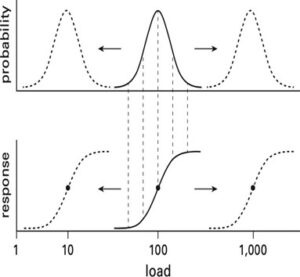
July 2024 Health Care Forum
There is a key principle that is totally absent from the idea of “homeostasis.” This principle concerns adaptation. It is a principle that operates throughout our body. Specifically, Adaptation is a process that sets the steepest response gain for most likely need/load.
 For instance, in this graph the most likely load is 100. So, you want the strongest response to be set at this mid-point (response curve) so that it can give the steepest gain to respond to this predicted load. Of course, the predicted load may shift to the right (1000). What you want to do is to have the response curve shift to the right to maintain this predicted load point. So, when prediction shifts (dotted line), then the response curve follows.
For instance, in this graph the most likely load is 100. So, you want the strongest response to be set at this mid-point (response curve) so that it can give the steepest gain to respond to this predicted load. Of course, the predicted load may shift to the right (1000). What you want to do is to have the response curve shift to the right to maintain this predicted load point. So, when prediction shifts (dotted line), then the response curve follows.
This applies to all systems in the body at all scales. Continual exercise predicts that you are going to have more weight. You are going to have a larger load. So, you strengthen the muscles. The appearance of dawn predicts brighter light. This leads the brain to reduce photoreceptor sensitivity. Overeating (a big problem today) predicts more glucose, so the pancreas should secrete more insulin. And this predicts over time more insulin. So the body reduces insulin receptors. This is termed “insulin resistance”; however, this is a mistake to call it “resistance” It sounds like a war. But it really is just a form of adaptation that is universal in the body and the brain. Many of these things should be treated not by more insulin (or some other substance), but by changing the predictions!
Conclusion: Homeostasis denies the brain’s primacy in physiological regulation. It denies that somatic pathophysiology is largely a response to chronic stress. It labels every somatic problem as a “disease” or “disorder”. There is a real need in most cases to change the predictions.
- Posted by Bill Bergquist
- On July 22, 2024
- 0 Comment



Leave Reply